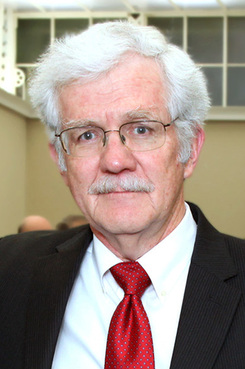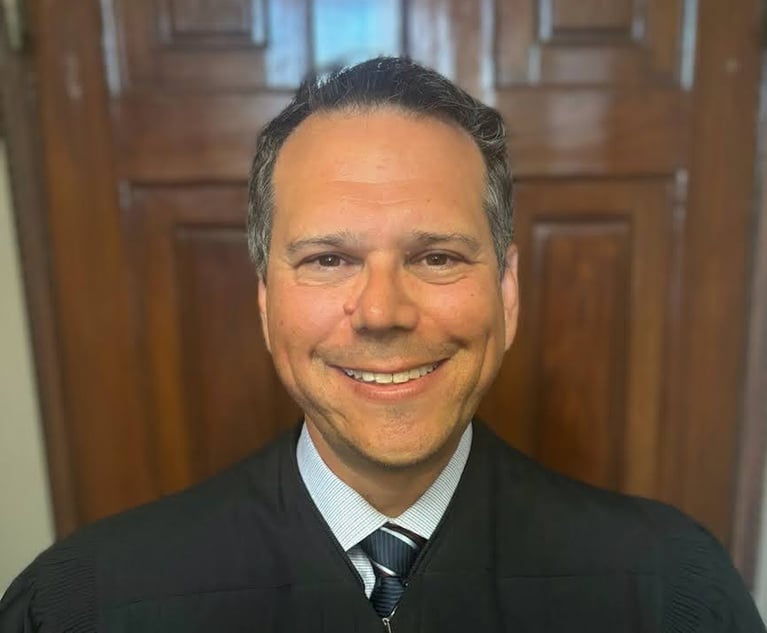'Really, Really Deadlocked': Eleventh Circuit Examines What Went Wrong When Judges Pressured a Holdout Juror
Chief Judge Ed Carnes wrote that an Alabama trial court's repeated admonitions to a jury deadlocked in an armed robbery case constituted improper coercion of the holdout juror, and that defense counsel should have called for a mistrial.
January 24, 2019 at 02:30 PM
8 minute read
The original version of this story was published on Daily Report
 Chief Judge Edward Carnes of the U.S. Court of Appeals for the Eleventh Circuit (Photo: Guerry Redmond)
Chief Judge Edward Carnes of the U.S. Court of Appeals for the Eleventh Circuit (Photo: Guerry Redmond)When an Alabama jury was unable to reach a verdict in an armed robbery case, two different judges tried to convince them to come to a consensus, issuing multiple jury charges and finally ordering all reading materials removed from the jury room, including the crossword puzzles a holdout was reportedly working on in lieu of deliberations.
The pressure worked, and the panel finally voted to convict Sumnar Brewster, whose subsequent bid to have a habeas court review his case for ineffective assistance of counsel was denied.
But a Jan. 22 opinion written by Chief Judge Ed Carnes of the U.S. Court of Appeals for the Eleventh Circuit said that, while a unanimous verdict is the desired outcome of a trial, there are times when judicial guidance can cross the line into coercion, and the circumstances leading up to Brewster's conviction should have spurred a call for a mistrial from his lawyer.
“It doesn't take a Clarence Darrow to realize that, if a jury has gone from 9 to 3 in favor of conviction, to 11 to 1 for it and is complaining about the lone holdout's behavior and her refusal to go along with the others, that jury is not headed toward an acquittal,” Carnes wrote, evoking the great defense lawyer.
“The cards had already been dealt, face up, and it was obvious who had the losing hand,” wrote Carnes with the concurrence of Judge Elizabeth Branch and Senior Judge Peter Fay.
The opinion also provided a short history and judicial analysis of how earlier tribunals handled cases in which determined holdouts bedeviled jurists along with their comrades in deliberation.
For centuries, English juries could be denied food or drink until they reached a unanimous verdict. If they remained undecided, the circuit judge could “carry them round the circuit from town to town in a cart” until a verdict “bounced out,” wrote Carnes, citing William Blackstone by way of U.S. Supreme Court Justice John Paul Stevens.
In colonial America, a judge presiding over a sedition case first threatened to have a recalcitrant juror named Bushel branded, then locked the panel up without anything to eat, drink or smoke.
“After nicotine withdrawal and the prospect of starvation failed to work,” the judge threatened to cut Bushel's throat, “posing the prospect of a dead juror to unlock a deadlocked jury,” wrote Carnes.
Bushel was not swayed and ultimately “escaped the experience unbranded and with his throat intact,” he wrote.
“We no longer try to coerce jurors to reach a verdict they cannot abide,” Carnes said. “Or at least most of the time we don't.”
As detailed in the opinion and underlying documents, Brewster was tried for two counts of armed robbery in Etowah Circuit Court in 2008.
The case went to the jury on the second day of trial, and after about 3½ hours, jurors sent out a note asking what would happen if one juror voted not guilty. The judge said the “court cannot answer but will recharge you on any instructions you wish.”
There is no indication the jury asked to be recharged.
Less than two hours later, the jury sent out another note saying they were deadlocked at 9-3 for conviction.
The judge read them Alabama's pattern instruction for an Allen or “dynamite” charge, named for the 1896 U.S. Supreme Court decision in Allen v. United States, which urges jurors to keep deliberating in good faith.
The panel deliberated the rest of the day then went home.
'The Holdout Held Out No More'
The next day they resumed their duties under another judge—the substitution is not explained—and after almost two hours sent out a note saying one juror was holding out and that “no amount of time was going to sway them.”
The judge told them to keep deliberating, and almost three hours later “the jury once again declared itself deadlocked—really, really deadlocked”—and that there was “no possibility of resolve.”
The prosecution asked for another Allen charge, but the judge instead sent written instruction commanding the jury to keep deliberating.
Shortly thereafter, a new note emerged saying the holdout was “unwilling to discuss the case with them.”
The judge brought the jury in and gave them “the longest additional instruction yet, covering seven-and-a-half pages of the transcript.”
The judge reminded them of their “solemn oath that you would well and truly try all the issues” and said they “are not at liberty to just ignore the instructions of the court.”
“He also reminded them that 'beyond a reasonable doubt' does not mean absolute certainty,” and ended by telling them “you took an oath. I take mine seriously. I hope you do the same.”
The jury went back in and 11 minutes later said the holdout refused to discuss the case “and had begun doing crossword puzzles.”
The judge responded by ordering the bailiff to remove all of the newspapers, books and magazines from the jury room.
“Eighteen minutes later, deprived of a way to shield herself from the importuning of the other jurors, the holdout held out no more,” Carnes wrote.
The jury “bounced out” a unanimous verdict, and Brewster was sentenced to life without parole.
In 2013, he filed a habeas petition in the U.S. District Court for the Northern District of Alabama asserting several claims, including one for ineffective assistance of counsel because his lawyer failed to object and demand a mistrial over the judges' pressuring the holdout juror.
In 2016, Judge R. David Proctor dismissed the petition, and Brewster appealed.
In overturning the district court, Carnes noted that Brewster's jury only deliberated 11 hours over two days, “which is not an inordinate amount of time. The problem, or one of them, is that during those 11 hours of deliberations the jury reported being deadlocked five times … and the firmness of the deadlock only increased as deliberations continued.”
The U.S. Supreme Court has barred federal judges from inquiring as to how a deadlocked jury is split, said Carnes, “which underscores the problem with a judge having that knowledge.”
“If the jury is aware that the court knows it is divided in favor of convicting the defendant, and the court repeatedly instructs the jury to continue deliberating, the jurors in the minority may feel pressured to join the majority in order to placate the judge,” he wrote.
In light of the judge's repeated admonitions and multiple use of the word “oath” in his final instruction, “the lone holdout must have felt as if they were aimed at her. It was her vote not to convict, after all, that had led to the lecture to begin with.”
While an attorney's failure to object or demand a mistrial may be attributed to trial strategy, in Brewster's case there was no indication that failure was due to any “tactical forethought,” the opinion said.
“Perhaps they thought any objection would be meritless. If so, they were really wrong,” Carnes said. “Or perhaps they didn't see the obvious signs of coercion or didn't know that a coerced verdict was unlawful.”
In any case, he said, “there was no conceivable reason, no reasonable strategy, for sitting silent and seeing how things would turn out.”
“The failure of Brewster's counsel to object and to move for a mistrial, as the coercive circumstances piled up, was prejudicial,” he wrote, and denial of his petition must be reversed.
Brewster's appeal was handled by Kevin Butler, Allison Case and Tobie Smith of the Federal Public Defender for the Northern District of Alabama. Case said they could not comment on the ruling.
The state is represented by Alabama Assistant Attorney General John Davis. Neither Davis nor Attorney General Steve Marshall responded to requests for comment.
This content has been archived. It is available through our partners, LexisNexis® and Bloomberg Law.
To view this content, please continue to their sites.
Not a Lexis Subscriber?
Subscribe Now
Not a Bloomberg Law Subscriber?
Subscribe Now
NOT FOR REPRINT
© 2025 ALM Global, LLC, All Rights Reserved. Request academic re-use from www.copyright.com. All other uses, submit a request to [email protected]. For more information visit Asset & Logo Licensing.
You Might Like
View All
Litigators of the Week: Simpson Thacher and ACLU Team To Challenge Louisiana's Ten Commandments Law

A Reporter and a Mayor: Behind the Scenes During the Eric Adams Indictment News Cycle

Even With New Business Courts, Texas Is a Long Way from Taking Delaware's Corporate Law Mantle
5 minute read
Trending Stories
- 15th Circuit Considers Challenge to Louisiana's Ten Commandments Law
- 2Crocs Accused of Padding Revenue With Channel-Stuffing HEYDUDE Shoes
- 3E-discovery Practitioners Are Racing to Adapt to Social Media’s Evolving Landscape
- 4The Law Firm Disrupted: For Office Policies, Big Law Has Its Ear to the Market, Not to Trump
- 5FTC Finalizes Child Online Privacy Rule Updates, But Ferguson Eyes Further Changes
Who Got The Work
J. Brugh Lower of Gibbons has entered an appearance for industrial equipment supplier Devco Corporation in a pending trademark infringement lawsuit. The suit, accusing the defendant of selling knock-off Graco products, was filed Dec. 18 in New Jersey District Court by Rivkin Radler on behalf of Graco Inc. and Graco Minnesota. The case, assigned to U.S. District Judge Zahid N. Quraishi, is 3:24-cv-11294, Graco Inc. et al v. Devco Corporation.
Who Got The Work
Rebecca Maller-Stein and Kent A. Yalowitz of Arnold & Porter Kaye Scholer have entered their appearances for Hanaco Venture Capital and its executives, Lior Prosor and David Frankel, in a pending securities lawsuit. The action, filed on Dec. 24 in New York Southern District Court by Zell, Aron & Co. on behalf of Goldeneye Advisors, accuses the defendants of negligently and fraudulently managing the plaintiff's $1 million investment. The case, assigned to U.S. District Judge Vernon S. Broderick, is 1:24-cv-09918, Goldeneye Advisors, LLC v. Hanaco Venture Capital, Ltd. et al.
Who Got The Work
Attorneys from A&O Shearman has stepped in as defense counsel for Toronto-Dominion Bank and other defendants in a pending securities class action. The suit, filed Dec. 11 in New York Southern District Court by Bleichmar Fonti & Auld, accuses the defendants of concealing the bank's 'pervasive' deficiencies in regards to its compliance with the Bank Secrecy Act and the quality of its anti-money laundering controls. The case, assigned to U.S. District Judge Arun Subramanian, is 1:24-cv-09445, Gonzalez v. The Toronto-Dominion Bank et al.
Who Got The Work
Crown Castle International, a Pennsylvania company providing shared communications infrastructure, has turned to Luke D. Wolf of Gordon Rees Scully Mansukhani to fend off a pending breach-of-contract lawsuit. The court action, filed Nov. 25 in Michigan Eastern District Court by Hooper Hathaway PC on behalf of The Town Residences LLC, accuses Crown Castle of failing to transfer approximately $30,000 in utility payments from T-Mobile in breach of a roof-top lease and assignment agreement. The case, assigned to U.S. District Judge Susan K. Declercq, is 2:24-cv-13131, The Town Residences LLC v. T-Mobile US, Inc. et al.
Who Got The Work
Wilfred P. Coronato and Daniel M. Schwartz of McCarter & English have stepped in as defense counsel to Electrolux Home Products Inc. in a pending product liability lawsuit. The court action, filed Nov. 26 in New York Eastern District Court by Poulos Lopiccolo PC and Nagel Rice LLP on behalf of David Stern, alleges that the defendant's refrigerators’ drawers and shelving repeatedly break and fall apart within months after purchase. The case, assigned to U.S. District Judge Joan M. Azrack, is 2:24-cv-08204, Stern v. Electrolux Home Products, Inc.
Featured Firms
Law Offices of Gary Martin Hays & Associates, P.C.
(470) 294-1674
Law Offices of Mark E. Salomone
(857) 444-6468
Smith & Hassler
(713) 739-1250






